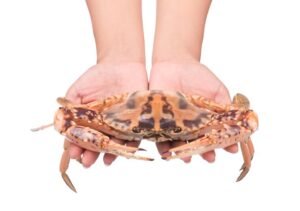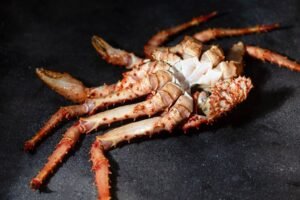What are Dungeness crab legs? Dungeness crab hails from the small town of Dungeness in Washington State. It plays a key role in the marine ecosystem. It is also highly valued in the culinary world. These crabs are harvested from the cool Pacific Northwest waters. They offer sweet and tender meat that is highly sought after.
Exploring the Appeal of Dungeness Crab Legs
The allure of Dungeness crab legs comes from their rich, buttery flavor. It is subtle yet profoundly satisfying. These crab legs are a staple in festive meals and gourmet dishes. They are not just food; they represent a cherished tradition in many coastal communities. Chefs and home cooks prize Dungeness crab for its versatility. They use it in many recipes that showcase its unique taste and texture.
We will explore the preparation and cooking methods of this esteemed seafood. We will also delve into its storied past. and we will uncover how this crab became a symbol of luxury and celebration in dining cultures worldwide. Join us on this mouth-watering journey. It promises to enrich your knowledge and might inspire your next seafood feast.
Historical Background
Origin and Commercial Harvesting
The Dungeness crab’s journey starts in the chilly, nutrient-rich waters of the Pacific Northwest. Named after Dungeness, Washington, where it was first harvested commercially in the late 1800s. These crabs quickly became a staple in the diets of Native American tribes and early settlers. The method of harvesting Dungeness crab started with simple traps and nets. It has evolved, but the essence of the hunt remains rooted in tradition and respect for the sea.
Popularity in Culinary Traditions
By the early 20th century, Dungeness crab had captured the hearts—and pots—of San Franciscans. It became a symbol of the city’s vibrant food scene. The crab’s sweet, tender meat made it popular among seafood lovers. It soon became a fixture in everything from holiday feasts to casual dining. The tradition of enjoying Dungeness crab has spread far and wide. It symbolizes not just a meal but a celebration of coastal life and bounty.
We will delve deeper into the storied past of these magnificent crabs. It is clear that their history is as rich and layered as their flavor. The ongoing appreciation and demand for Dungeness crab legs in culinary circles continues to celebrate this crustacean. It marks its journey from a regional delicacy to a global sensation.
Culinary Uses
Preparation Methods
Preparing Dungeness crab legs starts with selecting the freshest crabs. Once you have these precious crustaceans, the real fun begins. You should rinse the crab legs under cold water to remove any grit or sand. For a deeper flavor infusion, cracking the legs before cooking allows the flavors to seep into the meat.
Cooking Techniques and Recipes
Dungeness crab legs offer versatile cooking options that inspire any chef. You can steam, boil, or grill them, each method enhancing the crab’s natural flavors uniquely. Steaming preserves the meat’s delicate texture. Boiling infuses the crab with aromatic seasonings from the water. Grilling adds a smoky depth, perfect for summer.
A popular recipe is the classic crab boil, including spices and lemon. For simpler tastes, melted butter with garlic complements the crab’s natural sweetness perfectly.
The joy of cooking these crab legs lies not just in the tasty result but also in the process. It’s about preparing and sharing a nutritious, festive meal. This section celebrates the journey from ocean to table, inviting enthusiasts to savor the rich flavors and communal spirit that Dungeness crab embodies.
Nutritional Profile
Macronutrients and Calories
Dungeness crab legs boast an impressive nutritional profile. They are rich in protein yet low in calories, making them a guilt-free basis for a hearty meal. A 3-ounce serving provides about 15 grams of protein and fewer than 100 calories, ideal for those aiming to maintain or achieve a healthy weight without losing flavor.
Vitamins and Minerals
Beyond macronutrients, these crab legs are packed with essential vitamins and minerals. They are an excellent source of vitamin B12, crucial for nerve function and blood cell formation. They also offer significant amounts of selenium, important for immune and thyroid health. Zinc, another key nutrient, supports immune response and aids in wound healing.
This nutritional powerhouse not only satisfies the palate but also contributes to a well-rounded diet. Dungeness crab legs are a wise choice for those seeking flavor and health benefits.
Sustainable Practices and Conservation Efforts
Ensuring the Future of Dungeness Crab
As the popularity of Dungeness crab legs grows, so does the need for responsible fishing practices. This section delves into the conservation measures crucial for maintaining healthy crab stocks and their marine environment.
Sustainable Harvesting Techniques
We explore methods employed by fisheries to ensure the sustainability of Dungeness crab populations. These include regulated fishing seasons, size limits, and specially designed traps that minimize bycatch. These techniques inform consumers and encourage ethical seafood choices.
Community and Regulatory Efforts
This part highlights the roles of stakeholders, including local communities, environmental groups, and government agencies, in conserving crab habitats. Their efforts ensure that the crab fishing industry remains sustainable, supporting both the ecosystem and the economies that depend on it.
This section underscores the importance of sustainability in the ongoing enjoyment of Dungeness crab. It encourages readers to support practices that help preserve this valuable resource for future generations. This comprehensive approach not only completes the discussion on Dungeness crab but also aligns with growing consumer interest in sustainable seafood consumption.
Dungeness Crab in Cultural Traditions
Cultural Significance of Dungeness Crab
Dungeness crab holds a special place in various cultural traditions, particularly in the Pacific Northwest. This section could explore how the crab has been integrated into local festivals, culinary competitions, and holiday traditions. It serves as a symbol of community and abundance in many coastal regions.
Festivals and Celebrations
We can detail the major events that celebrate the Dungeness crab, such as the annual crab festivals that attract thousands of visitors. These festivals often feature crab cooking contests, educational workshops, and other activities that highlight the crab’s role in local economies and cultures.
Culinary Traditions Across Generations
This part could also delve into the ways in which Dungeness crab has been used in traditional recipes passed down through generations. It would look at how these traditions have been preserved and how they evolve in modern culinary practices, ensuring the legacy of Dungeness crab continues to enrich dining experiences.
By exploring the cultural impact of Dungeness crab, this section would not only provide a historical perspective but also celebrate the deep connection between this cherished seafood and the communities that hold it dear. This exploration adds another layer to the narrative, connecting readers with the human stories behind the popular crustacean.



